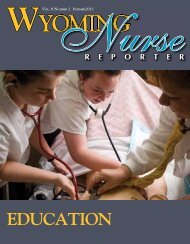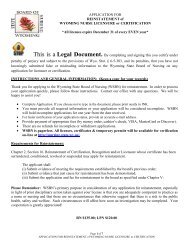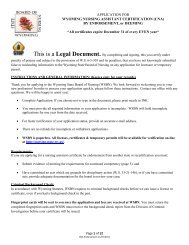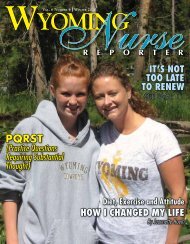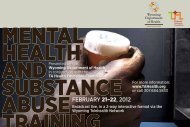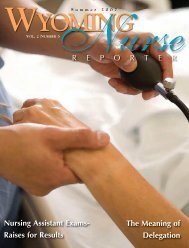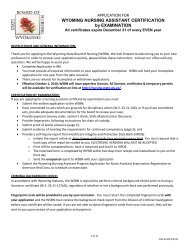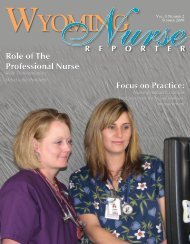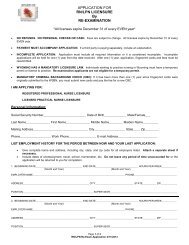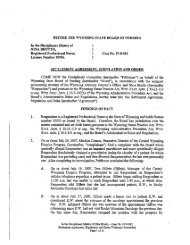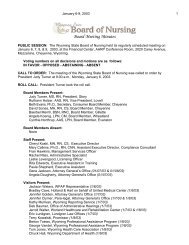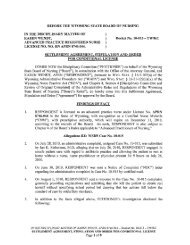Nurse Reporter Spring 2009 - Wyoming State Board of Nursing
Nurse Reporter Spring 2009 - Wyoming State Board of Nursing
Nurse Reporter Spring 2009 - Wyoming State Board of Nursing
Create successful ePaper yourself
Turn your PDF publications into a flip-book with our unique Google optimized e-Paper software.
NCSBN Celebrates<br />
30 th<br />
Founded in 1978 as an independent notfor<br />
pr<strong>of</strong>it-organization, the National Council <strong>of</strong><br />
<strong>State</strong> <strong>Board</strong>s <strong>of</strong> <strong>Nursing</strong> Inc. (NCSBN) marked<br />
the milestone <strong>of</strong> reaching its 30th anniversary<br />
this year.<br />
NCSBN’s membership is comprised <strong>of</strong> the<br />
boards <strong>of</strong> nursing in the 50 states, the District <strong>of</strong><br />
Columbia, and four U.S. territories — American<br />
Samoa, Guam, Northern Mariana Islands and the<br />
Virgin Islands. These boards <strong>of</strong> nursing protect<br />
the public by ensuring that safe and competent<br />
nursing care is provided by licensed nurses and<br />
NCSBN is the vehicle through which the boards<br />
act and counsel together on matters <strong>of</strong> common<br />
interest.<br />
NCSBN member boards are charged with the<br />
responsibility <strong>of</strong> providing regulatory excellence<br />
for public health, safety and welfare. They recognize<br />
that the best way to guard the safety <strong>of</strong> the<br />
public is to ensure that nurses entering the workforce<br />
have the necessary knowledge and skills to<br />
practice. U.S. boards <strong>of</strong> nursing regulate more<br />
than 2.9 million licensed nurses, the second largest<br />
group <strong>of</strong> licensed pr<strong>of</strong>essionals in the U.S.<br />
“NCSBN had humble beginnings when it<br />
opened its doors in Madison, Wisconsin, with one<br />
employee and a $10,000 budget,” remarks Laura<br />
Rhodes, MSN, RN, NCSBN board <strong>of</strong> director’s<br />
president, “but it had very l<strong>of</strong>ty ideals.” NCSBN<br />
can trace its roots to the American <strong>Nurse</strong>s Association<br />
(ANA) Council on <strong>State</strong> <strong>Board</strong>s <strong>of</strong><br />
<strong>Nursing</strong>. The reason for its creation arose out <strong>of</strong><br />
recognition that in order to guard the safety <strong>of</strong><br />
the public, the regulation needed to be a separate<br />
entity from the organization representing pr<strong>of</strong>essional<br />
nurses.<br />
NCSBN recognizes that it is imperative that<br />
nurses entering the workforce have the necessary<br />
knowledge and skills to practice. One <strong>of</strong> NCSBN’s<br />
primary objectives is devoted to developing a psychometrically<br />
sound and legally defensible nurse<br />
licensure examination consistent with current<br />
nursing practice. The NCLEX-RN and NCLEX-<br />
PN Examinations developed and administered by<br />
NCSBN are constantly and rigorously evaluated<br />
to keep pace with the rapidly evolving health<br />
care environment.<br />
A very significant moment in NCSBN history<br />
came on April 1, 1994, when NCSBN became<br />
the first organization to implement computerized<br />
adaptive testing (CAT) for nationwide licensure<br />
examination. Since then, more than 2.4 million<br />
U.S. candidates for nurse licensure have taken<br />
the NCLEX exam via CAT.<br />
The increasing global nature <strong>of</strong> the world and<br />
influx <strong>of</strong> internationally educated nurses into<br />
U.S. nursing practice led NCSBN to the decision<br />
to <strong>of</strong>fer NCLEX testing abroad for the first time<br />
in 2005. Since then, nearly 63,000 international<br />
nurse licensure candidates have taken the NCLEX<br />
in the 10 countries where it is now <strong>of</strong>fered.<br />
With help from the nursing education community,<br />
NCSBN created the Learning Extension<br />
to help students, nurses and nurse educators meet<br />
their educational goals. The Learning Extension<br />
currently <strong>of</strong>fers 35 online courses covering a wide<br />
range <strong>of</strong> topics for nurses and nurse regulators.<br />
Since its inception in 1998, the Learning Extension<br />
has reached over 134,000 nurses in 120<br />
countries.<br />
NCSBN recognizes that health care is a<br />
constantly evolving field. In order for nursing<br />
regulation to keep pace in this rapidly changing<br />
environment, NCSBN has adopted numerous<br />
position statements, guiding principles and<br />
model acts and rules for use by member boards<br />
<strong>of</strong> nursing. In recent years, these include: the<br />
approval <strong>of</strong> the NCSBN Model Practice Act,<br />
which includes the authority to conduct criminal<br />
background checks; the adoption <strong>of</strong> the proposed<br />
standard for drug screening results; approving position<br />
papers, “Working with Others: Delegation<br />
and Other Health Care Interfaces” and “<strong>Nursing</strong><br />
Education Clinical Instruction In Pre-licensure<br />
<strong>Nursing</strong> Programs”; and enacting the Model Act<br />
and Rules For Delegation, the <strong>Nursing</strong> Assistant<br />
Regulatory Model and the Model Process for<br />
Criminal Background Checks.<br />
In 2008, NCSBN welcomed its first international<br />
associate member. This new membership<br />
category is designed to provide a forum by which<br />
nursing regulatory bodies from around the globe<br />
can join in a dialogue regarding issues <strong>of</strong> common<br />
concern. Additionally, all members are able to<br />
share information and knowledge in a multicultural<br />
exchange <strong>of</strong> thoughts and ideas.<br />
NCSBN works collaboratively with other<br />
nursing and health care organizations as well as<br />
local, state, national and international government<br />
agencies aiming toward realizing its vision<br />
<strong>of</strong> building regulatory expertise worldwide.<br />
“We always have been and always will be<br />
proud to be on the forefront <strong>of</strong> nursing regulation,”<br />
concludes Rhodes.<br />
The National Council <strong>of</strong> <strong>State</strong> <strong>Board</strong>s <strong>of</strong><br />
<strong>Nursing</strong>, Inc. (NCSBN) is a not-for-pr<strong>of</strong>it organization<br />
whose membership comprises the boards <strong>of</strong><br />
nursing in the 50 states, the District <strong>of</strong> Columbia<br />
and four U.S. territories.<br />
Mission: The National Council <strong>of</strong> <strong>State</strong> <strong>Board</strong>s <strong>of</strong><br />
<strong>Nursing</strong> (NCSBN), composed <strong>of</strong> Member <strong>Board</strong>s,<br />
provides leadership to advance regulatory excellence<br />
for public protection.<br />
Wy o m i n g Nu r s e Re p o r t e r 23



